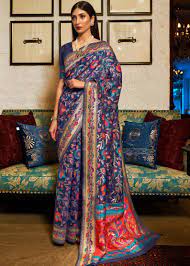Introduction
Kashmir, often referred to as “Paradise on Earth,” is not only known for its breathtaking landscapes and rich culture but also for its exquisite craftsmanship, which is showcased in the beautiful Kashmiri sarees. These sarees hold a special place in the hearts of women across India and beyond, as they embody the rich cultural heritage and artistic finesse of the region. In this blog, we will delve into the history, craftsmanship, and allure of Kashmiri sarees, exploring why they continue to captivate the world with their unique charm.

1. A Glimpse into the History
The history of Kashmiri sarees dates back centuries, with their origin deeply rooted in the artistic traditions of the region. It is believed that the art of weaving in Kashmir was introduced by Persian immigrants during the reign of Sultan Zain-ul-Abidin in the 15th century. Over time, the craft evolved and assimilated local motifs, patterns, and techniques, creating a distinctive identity for Kashmiri sarees.
2. The Art of Weaving
The production of a single Kashmiri saree is a labor-intensive process. Firstly, involving skilled artisans who dedicate hours of meticulous work to create these masterpieces. Secondly, the process usually starts with sourcing the finest-quality silk or Pashmina, which forms the base of the saree. Thirdly, Pashmina, derived from the underbelly of the Changthangi goats found in the high-altitude regions of Ladakh, is known for its softness and warmth. Fourthly, the weaving of the saree is traditionally done on a handloom, where every thread is carefully intertwined to create intricate patterns. Fifthly, the most distinctive feature of Kashmiri sarees is the Kani or Kasheeda work, which involves weaving elaborate designs using small wooden sticks. Lastly, this technique allows for the creation of unique and detailed motifs that give the saree its distinct identity.
3. Timeless Motifs and Designs
Additionally, Kashmiri sarees are known for their graceful and intricate designs that depict the region’s natural beauty and cultural heritage. Moreover, the motifs often feature delicate paisleys, chinar leaves, flowers, and birds, symbolizing the harmony between man and nature. Furthermore, these designs are not just limited to sarees but also find their way into shawls, stoles, and other traditional garments.
In addition to the motifs mentioned earlier, another popular design in Kashmiri sarees is the “Jal” pattern, which resembles a net-like structure. This design requires exceptional skill and patience, as it involves interlacing threads to create a mesmerizing effect on the fabric.
4. The Vibrant Color Palette
Kashmiri sarees boast a wide array of vibrant colors that reflect the region’s diverse landscape. The use of rich and bold hues like royal blue, deep maroon, fiery red, and emerald green adds a touch of regal elegance to these sarees. The choice of colors often varies based on the occasion or the season. For instance, lighter pastel shades are preferred during spring and summer, while deeper tones are favored during autumn and winter.
5. The Pashmina Connection
The epitome of luxury and warmth, Pashmina silk plays a significant role in the realm of Kashmiri sarees. Transitionally, derived from the Persian word “Pashm,” meaning soft gold, it is renowned for its incredible softness and insulating properties. When combined with silk, it creates a fabric that is not only lightweight and breathable but also exudes a sense of opulence. Transitionally, Pashmina silk sarees, often adorned with intricate embroidery and zari work, are highly coveted by saree connoisseurs worldwide. These sarees are not just fashion statements but also investment pieces that are passed down through generations.
6. Embracing Kashmiri Sarees Today
In recent years, there has been a resurgence of interest in traditional Indian textiles, including Kashmiri sarees. The growing appreciation for handmade and eco-friendly products has led to an increased demand for these authentic creations. Many designers and fashion houses are now collaborating with Kashmiri artisans to give this age-old craft a contemporary twist, making it accessible to a wider audience. Furthermore, the Indian government’s initiatives to promote indigenous crafts and support local artisans have also contributed to the preservation and promotion of Kashmiri sarees. Various exhibitions, cultural events, and fashion shows have been organized to showcase the elegance and timelessness of these exquisite sarees.
Conclusion
Kashmiri sarees are not just garments; they are a reflection of the rich cultural tapestry and artistic heritage of the Kashmiri people. The meticulous craftsmanship, intricate designs, and vibrant colors make these sarees an embodiment of grace, elegance, and opulence. Owning a Kashmiri saree is akin to possessing a piece of art that has been crafted with love, skill, and a deep-rooted cultural heritage. As these timeless creations continue to transcend trends and generations, they remain a symbol of timeless beauty and an ode to the artisans who pour their heart and soul into every thread, creating magic for the world to cherish. So, the next time you drape yourself in a Kashmiri saree, remember that you are carrying a piece of paradise with you, evoking the mystique and charm of the enchanting land of Kashmir.
You may also like
-
Children’s Polarized Sunglasses – A Complete Guide for Parents
-
The Ultimate Guide to Styling Your Accent Lab Diamond Ring
-
A Guide to Purchasing the Perfect Diamond Tennis Bracelet
-
Stunning Highlights: Elevate Your Look with Alibonnie’s Colored Creations
-
Elevating Your Style with Custom Suits in Bangkok
